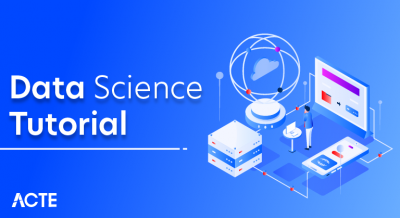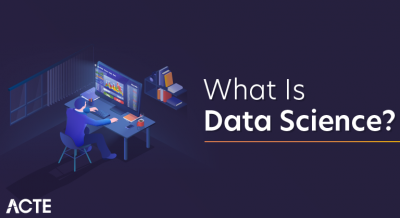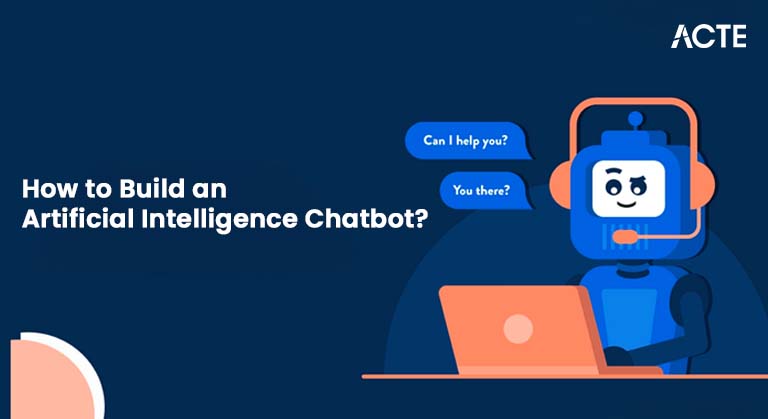
- Introduction to AI Chatbots
- Types of Chatbots (Rule-based vs AI)
- Defining the Purpose of the Chatbot
- Choosing the Right NLP Platform
- Designing the Chat Flow
- Training the Model with Data
- Integration with Messaging Platforms
- Tools and Frameworks (Rasa, Dialogflow)
Introduction to AI Chatbots
Artificial Intelligence (AI) chatbots are advanced computer programs designed to simulate human-like conversations using natural language processing (NLP) and machine learning. These bots have transitioned from basic scripted responders to intelligent systems capable of understanding user intent, context, and even emotion. AI chatbots are now essential tools in industries like customer service, healthcare, retail, and education, offering instant, round-the-clock assistance. Unlike traditional rule-based bots, AI chatbots learn from interactions, improving their accuracy and adaptability over time. They can handle multiple queries simultaneously, automate repetitive tasks, and provide personalized experiences, thereby enhancing efficiency and reducing costs for businesses. Additionally, Data Science training enables teams to leverage advanced analytics, making it easier to derive actionable insights, improve decision-making, and optimize operations. The core technologies that power these bots include NLP, deep learning, and neural networks, enabling them to comprehend language nuances and generate relevant responses. AI chatbots are also becoming more conversational and context-aware, offering users a smoother and more engaging interaction. Whether used in mobile apps, websites, or virtual assistants, AI chatbots are revolutionizing how people interact with digital services, making communication faster, smarter, and more accessible in today’s technology-driven world.
Would You Like to Know More About Data Science? Sign Up For Our Data Science Course Training Now!
Types of Chatbots (Rule-based vs AI)
- Rule-based Chatbots: These bots follow predefined paths or decision trees, responding based on specific keywords or scripted rules. They are easy to build and ideal for simple tasks like answering FAQs.
- AI-powered Chatbots: These chatbots use AI, machine learning, and natural language processing to understand user intent, context, and sentiment, enabling dynamic, human-like conversations. An Artificial Neural Network use case helps improve pattern recognition, refining responses and enhancing the chatbot’s conversational abilities.
- Learning Capability: Rule-based bots do not learn from interactions they only follow programmed instructions. AI bots, however, continuously learn and improve over time through user interactions.
Chatbots can be broadly categorized into two main types: rule-based and AI-powered. Each type serves different purposes based on complexity, user needs, and interaction goals. Understanding their key differences helps in selecting the right chatbot for a specific application.
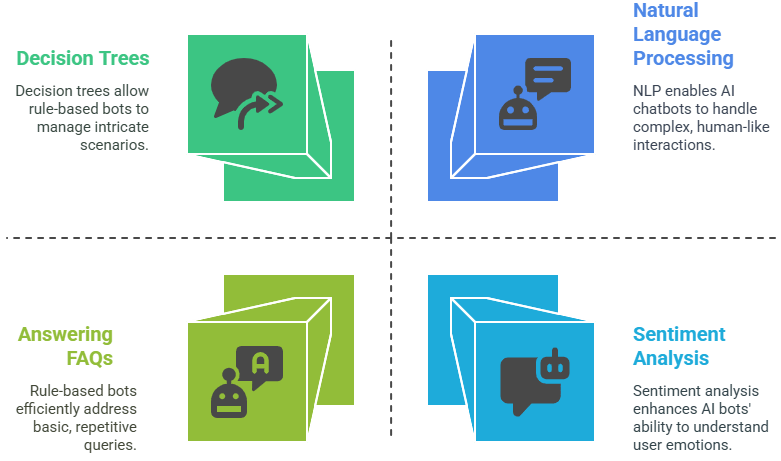
- Flexibility: Rule-based bots struggle with unexpected questions or off-script inputs. AI chatbots handle a wide range of queries, including those not explicitly pre-programmed.
- Development Complexity: Rule-based bots are easier and quicker to develop. AI chatbots require more data, training, and technical resources but offer greater capabilities.
- Use Case Suitability: Rule-based bots are suitable for straightforward, repetitive tasks. AI chatbots are better suited for complex, evolving interactions that require deeper understanding.
Defining the Purpose of the Chatbot
Defining the purpose of a chatbot is a crucial first step in its development, as it directly influences its design, functionality, and overall effectiveness. A clearly defined purpose ensures the chatbot meets specific user needs and business objectives, whether it’s providing customer support, generating leads, automating tasks, or delivering personalized recommendations. The chatbot’s goals should align with the organization’s broader strategy and be tailored to the target audience’s expectations. What is Data Analytics can be used to analyze user interactions, providing insights that help refine the chatbot’s performance and ensure it meets user needs effectively. For instance, a support chatbot may be designed to resolve common customer issues quickly, while a sales-oriented chatbot might focus on engaging users and guiding them through a purchase process. Without a clear purpose, a chatbot may offer a confusing or inefficient user experience, leading to frustration and decreased engagement. Developers should start by identifying the problems the chatbot aims to solve, the types of questions it will handle, and the outcomes it should achieve. They should also consider the platform where the chatbot will operate, such as a website, messaging app, or voice assistant, as this can impact the interaction style. Ultimately, defining the chatbot’s purpose provides a strong foundation for building a useful, goal-oriented solution that delivers real value to both users and the business.
Want to Pursue a Data Science Master’s Degree? Enroll For Data Science Masters Course Today!
Choosing the Right NLP Platform
- Language Support: Choose a platform that supports the languages your target audience speaks, including regional dialects and multilingual capabilities if needed.
- Accuracy in Intent Recognition: Evaluate how well the platform identifies user intent and entities, especially in complex or ambiguous queries.
- Ease of Integration: Ensure the platform can easily integrate with your existing systems, APIs, databases, or messaging channels like WhatsApp, Slack, or websites. What is Predictive Analytics can enhance this integration by forecasting user needs and behaviors, allowing the chatbot to deliver more personalized and proactive interactions.
- Customizability and Training: Opt for a platform that allows you to train custom models, update responses, and fine-tune NLP capabilities based on user interactions.
- Scalability and Performance: The platform should handle increasing traffic and queries efficiently as your user base grows.
- Cost and Licensing: Consider the pricing model, whether it’s free, subscription-based, or pay-as-you-go, and ensure it fits within your project’s budget while offering the features you need.
- Collect Relevant Data: Gather chat transcripts, customer queries, and support tickets to build a rich dataset that reflects real user interactions.
- Define Intents and Entities: Categorize user intents (e.g., “book appointment”) and extract entities (e.g., date, time) to help the model understand different conversation goals.
- Create Diverse Training Examples: Provide multiple variations of user intent to help the model handle different phrasings and slang. Python Programming advantages and disadvantages can assess how efficiently the chatbot processes inputs, using Python’s simplicity for improved performance.
- Balance the Dataset: Ensure the training data covers all major intents evenly to prevent the model from favoring more frequent queries.
- Test and Evaluate: Continuously test the model with unseen data to measure performance and identify areas needing improvement.
- Retrain and Refine Regularly: Update the model with new user inputs and feedback to keep it current, relevant, and more accurate over time.
Selecting the right Natural Language Processing (NLP) platform is essential for building an effective chatbot that understands and responds to user input accurately. The choice depends on factors such as the chatbot’s complexity, language support, integration needs, and budget. A well-suited NLP platform enhances user experience, ensures accurate intent detection, and allows for easier scalability and maintenance.
Designing the Chat Flow
Designing the chat flow is a critical step in creating a seamless and engaging chatbot experience. It involves mapping out how conversations will progress based on user inputs, ensuring interactions are logical, intuitive, and goal-oriented. A well-designed chat flow guides users naturally from one step to the next, helping them find information, complete tasks, or resolve issues with minimal effort. It begins with identifying key user intents and defining conversation paths for each, including greetings, queries, responses, and possible follow-up actions. Designers must anticipate user behavior, including common questions, unclear inputs, or off-topic responses, and plan appropriate fallback messages to maintain engagement. Data Science training equips designers with the skills to analyze user interactions, predict behavior patterns, and optimize fallback strategies for more effective and responsive conversational experiences. The tone and style of communication should align with the brand’s voice, whether formal, friendly, or playful, creating a consistent user experience. Decision trees, flowcharts, or chatbot design tools can help visualize the structure and test for clarity. Incorporating elements like quick replies, buttons, and personalized messages enhances usability and speeds up interactions. Testing the chat flow with real users is essential to identify friction points and optimize the experience. Ultimately, a thoughtfully designed chat flow not only improves user satisfaction but also ensures the chatbot effectively meets its intended purpose across various use cases.
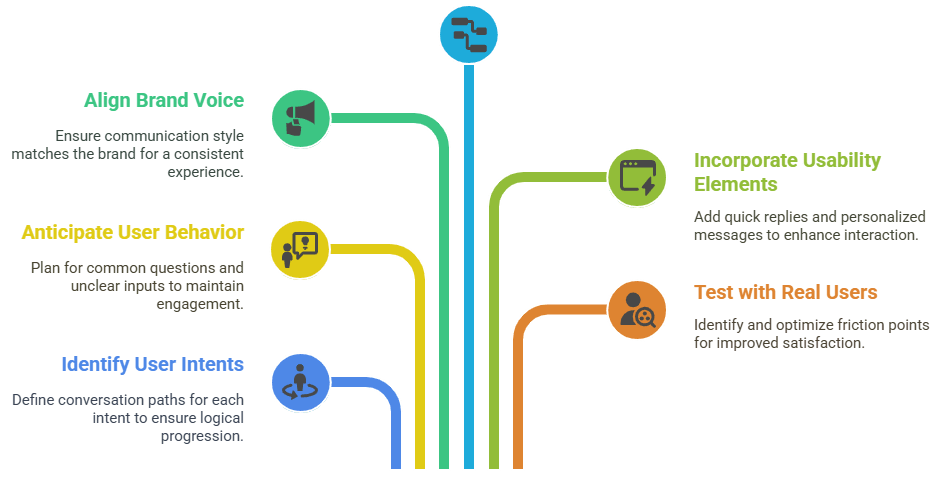
Training the Model with Data
Training the chatbot’s model with quality data is essential to ensure it understands user inputs accurately and responds appropriately. This process involves feeding the model real or simulated conversation data, allowing it to recognize patterns, intents, and entities. The better the training data, the more intelligent and effective the chatbot becomes in handling diverse user interactions. A well-trained model improves accuracy, reduces misunderstandings, and enhances the overall user experience.
Integration with Messaging Platforms
Integrating a chatbot with messaging platforms is a vital step in making it accessible to users where they already communicate, such as WhatsApp, Facebook Messenger, Slack, Telegram, or a company’s website. This integration ensures a seamless user experience by enabling real-time interactions within familiar environments. It allows businesses to engage customers more effectively, provide instant support, and automate responses without requiring users to switch platforms. Successful integration involves connecting the chatbot’s backend with the messaging service’s API, handling message formats, user authentication, and ensuring data privacy. Each platform may have its own technical requirements and limitations, so developers must tailor the chatbot to function smoothly across multiple channels. Additionally, the chatbot’s design such as button styles, quick replies, and message length should be optimized for each platform to maintain usability and visual consistency. Integration also enables advanced features like push notifications, user tracking, and analytics, offering deeper insights into customer behavior. What is Data Engineering ensures the smooth collection, transformation, and storage of data, supporting these features with reliable and scalable infrastructure. Testing the chatbot in real-world conditions across all integrated platforms is essential to identify and resolve compatibility issues. Ultimately, effective integration expands the chatbot’s reach, enhances user convenience, and supports a more unified communication strategy for businesses aiming to deliver responsive, round-the-clock service.
Go Through These Data Science Interview Questions & Answer to Excel in Your Upcoming Interview.
Tools and Frameworks (Rasa, Dialogflow)
Choosing the right tools and frameworks is essential for building efficient and intelligent chatbots, and two of the most widely used platforms are Rasa and Dialogflow. Rasa is an open-source framework that offers full control over the chatbot’s logic, data, and deployment, making it ideal for developers seeking customization and on-premise hosting. It supports advanced natural language understanding (NLU), dialogue management, and machine learning-based training, allowing businesses to build highly tailored conversational experiences. Furthermore, Data Science training empowers teams to harness data-driven insights, enhancing the effectiveness of these conversational systems and enabling more informed decision-making. On the other hand, Dialogflow, developed by Google, is a cloud-based platform that offers ease of use, quick setup, and robust integration with Google’s ecosystem, including Google Assistant. It is beginner-friendly and comes with pre-built agents, powerful NLP capabilities and multi-language support, making it a great option for rapid development. While Dialogflow handles much of the backend automatically, Rasa offers more transparency and flexibility, especially for complex workflows and data privacy concerns. Both tools provide APIs, webhook support, and integration with popular messaging platforms. The choice between Rasa and Dialogflow ultimately depends on the project’s technical requirements, customization needs, deployment preferences, and developer expertise. Together, these frameworks represent two ends of the chatbot development spectrum managed convenience versus complete control.


